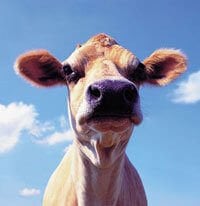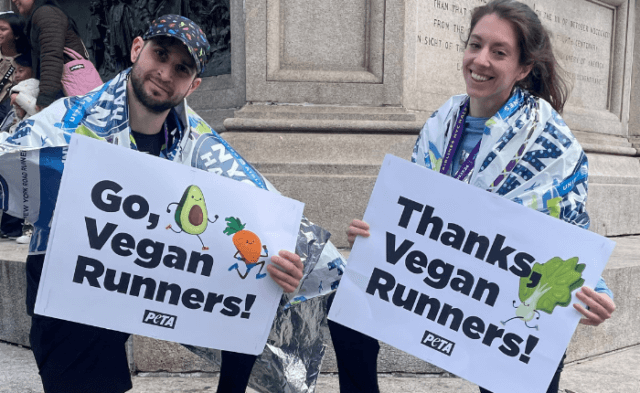In part 2 of this series focusing on the many things that PETA does to help farmed animals, I talked about ways in which we work to attract media attention, putting—or keeping—animal rights issues in the news and reaching countless people worldwide. At the same time, PETA is also working to reach people on popular social media sites, where many—especially young people—spend much of their time.
PETA is the most-engaged-with advocacy organization on Facebook, Twitter, and Instagram—
more people like, comment on, share, and retweet PETA’s content than that of any other advocacy organization, regardless of cause.
Here are just a few of the ways that PETA is connecting with people online, via computers, smartphones, tablets, and other popular devices:
On Facebook
In the first half of 2016, PETA’s marketing team shared 474 posts related to vegan eating on the PETA, peta2, and PETA Latino Facebook pages. They received a combined 7,251,092 likes by the end of June 2016, for a total of 620 million impressions (the number of times a post is displayed).
PETA’s graphic “Chicken Dinner in Reverse” video was shared 151,500 times and received 14 million video views on our main Facebook page alone.
Your Chicken Dinner in ReversePeople are so removed from the process. Your chicken dinner, IN REVERSE.
Posted by PETA (People for the Ethical Treatment of Animals) on Monday, May 2, 2016
The moving “Year of the Vegan” video, which shows one person’s progress in going vegan, has received more than 1.9 million video views.
How Do You Know You’re Vegan?She loves meat, so she never saw it coming.
Her mom’s reaction is perfect! #TheYearOfVegan
Posted by PETA (People for the Ethical Treatment of Animals) on Thursday, January 21, 2016
“Bite-sized” information is easy to share on social media. For example, this short video that uses footage from a PETA investigation but focuses on a cruel device used to prevent calves from nursing has received more than 1 million video views.

PETA produces a lot of bite-sized content by cutting longer videos into shorter segments. People who might not have time to watch the full-length version of “Glass Walls”—PETA’s popular video narrated by Paul McCartney—may at least be willing to watch the pig segment of it.
What Pigs Go Through for BaconNo bacon is worth this.
[GRAPHIC]
Posted by PETA (People for the Ethical Treatment of Animals) on Tuesday, May 10, 2016
Sharing a variety of content is a successful strategy. This short “Internet meme”–style video that shows newborn male chicks discarded by the egg industry and tossed onto a truck bound for slaughter received more than 700,000 video views on PETA’s main Facebook page.
THIS is what’s wrong with the chicken & egg industries.
They just keep dumping them in 🙁
Posted by PETA (People for the Ethical Treatment of Animals) on Sunday, June 26, 2016
After each pro-vegan social media post, PETA presents a link to our vegan starter kit or other resources that will help people make personal changes to help animals.


On Twitter
Content on the main @peta Twitter page is often retweeted significantly more than content tweeted by other animal-protection organizations. For example, in April 2016 alone, PETA’s tweets were retweeted more than 108,000 times—more than tweets from four other admired animal-advocacy organizations combined.
In the first half of 2016, PETA published a combined total of 3,033 tweets related to vegan eating on our PETA, peta2, and PETA Latino Twitter account pages, reaching a combined 799,916 followers for a total of 45 million impressions.
“PETA” trended on Twitter on Super Bowl Sunday, when our tweets about chicken wings went viral.

A tweet from a Twitter user who shared PETA’s “Chicken in Reverse” video and commented that “the vegans … have a point …” received almost 52,000 retweets.

PETA staff members work seven days a week to correspond with people on Facebook and Twitter. Many times a day, people respond to our posts with questions or comments about eating vegan, such as this one:

A PETA social media correspondent responded to this woman just an hour and 10 minutes later with encouragement and a link to more resources:

In April 2016, the main @PETA page on Instagram received more than 55,000 views—and considerably more comments—than the same respected animal-protection organizations referenced above, regarding Twitter.
In the first half of 2016, PETA published a combined total of 367 posts related to vegan eating on PETA’s, peta2’s, and PETA Latino’s Instagram accounts, reaching a combined 412,517 followers and receiving a total of 833,000 likes.
PETA posted a PETA Living recipe video for vegan cream-filled eggs on Instagram around Easter. It received more than 108,000 video views.

Via Online Video
PETA’s presence on social media has grown by leaps and bounds. Five years ago, PETA received 2 million views in 365 days—encompassing all the issues that we work on. Now, we receive, on average, 75 million video views every day and are on track for 1 billion video views in 2016. Looking only at vegan-related videos, across all social media platforms, including YouTube, PETA received 104 million video views for the year midway through 2016.
PETA’s vegan recipe videos have grown increasingly popular, racking up more than 18 million views in the first six months of 2016.

Our popular “… in 60 Seconds” video series includes “Factory Farming in 60 Seconds” and many other specific topics, such as foie gras, bacon, the dairy industry, chicken, and cheese.
Sixty-second videos generally work well on social media, where there is much to look at and people tend to move along quickly. PETA has managed to convey serious images to countless people in virtually no time at all. “El pollo en exactamente 60 segundos,” for instance, received half a million video views on the PETA Latino Facebook page in March alone.
PETA is known for its celebrity supporters. One of the most popular celebrity videos relating to vegan eating is “Face Your Food,” an attention-grabbing video featuring Peter Dinklage. The video, which PETA promoted to correspond with the premiere of the new season of Game of Thrones, has received 849,000 views on the main PETA page alone.
‘Game of Thrones’ Star Shows You Who’s Really DyingGame of Thrones star Peter Dinklage challenges you to face your FOOD. Can you make it to the end?
Posted by PETA (People for the Ethical Treatment of Animals) on Sunday, April 24, 2016
PETA Websites
And of course, PETA.org, peta2.com, and PETALatino.com are popular places to learn about vegan living and other animal-related issues. Videos relating to vegan eating have received an estimated 17.5 million page views in recent times. The Accidentally Vegan Food List was PETA’s top vegan eating resource page in recent months, with more than 500,000 page views. And the ever-popular Cooking Mama parody game received 760,000 page views in the first half of the year.
Please stay tuned for the fourth and final segment of this series, in which you’ll learn how PETA works with major corporations and other companies to promote vegan living and help farmed animals.





